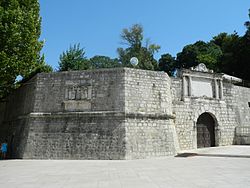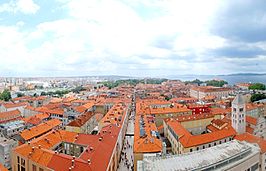Zara, Dalmatia
| Zadar | ||||||||
|---|---|---|---|---|---|---|---|---|
| City | ||||||||
| City of Zadar Grad Zadar |
||||||||
Counter-clockwise from top: Panorama view from Cathedral Bell Tower, Church of St. Donatus and Bishops' palace on the Ancient Roman Forum, University of Zadar, St Dominic's Church, Monument to the Sun, People's Square.
|
||||||||
|
||||||||
| Location of Zadar in Croatia | ||||||||
| Coordinates: 44°6′51″N 15°13′40″E / 44.11417°N 15.22778°ECoordinates: 44°6′51″N 15°13′40″E / 44.11417°N 15.22778°E | ||||||||
| Country |
|
|||||||
| County |
|
|||||||
| Liburni settlement | 9th century BC | |||||||
|
Roman foundation Colonia Iulia Iader |
48 BC | |||||||
| Government | ||||||||
| • Mayor | Branko Dukić (HDZ) | |||||||
| • City Council |
31 members
|
|||||||
| Area | ||||||||
| • City | 25 km2 (10 sq mi) | |||||||
| • Metro | 194 km2 (75 sq mi) | |||||||
| Population (2011 census) | ||||||||
| • City | 75,082 | |||||||
| • Density | 3,000/km2 (7,800/sq mi) | |||||||
| Time zone | CET (UTC+1) | |||||||
| • Summer (DST) | CEST (UTC+2) | |||||||
| Postal code | 23000 | |||||||
| Area code(s) | 23 | |||||||
| Vehicle registration | ZD | |||||||
| Patron saints |
Saint Anastasia Saint Chrysogonus Saint Simeon Saint Zoilus |
|||||||
| Website | www |
|||||||
| Venetian Works of Defence between 15th and 17th centuries: Stato da Terra – western Stato da Mar | |
|---|---|
|
Native name Croatian: Obrambeni sustavi Republike Venecije u razdoblju od 15. do 17. stoljeća |
|

Part of more than 3km long Zadar fortifications
|
|
| Location |
Zadar County, |
| Type | Cultural |
| Criteria | iii, iv |
| Designated | 2017 (41 Session) |
| Endangered | 1991–1995 |
Diklo redirects here. For the village, see Diklo (village)
Zadar (pronounced [zâdar]; see other names) is the oldest continuously inhabited city in Croatia. It is situated on the Adriatic Sea, at the northwestern part of Ravni Kotari region. Zadar serves as the seat of Zadar County and the wider northern Dalmatian region. The city proper covers 25 km2 (9.7 sq mi) with a population of 75,082 in 2011, making it the fifth largest city in the country.
The area of present-day Zadar traces its earliest evidence of human life from the late Stone Age, while numerous settlements have been dated as early as the Neolithic. Before the Illyrians, the area was inhabited by an ancient Mediterranean people of a pre-Indo-European culture. Zadar traces its origin to its 4th-century BC founding as a settlement of the Illyrian tribe of Liburnians known as Iader.
In 59 BC it was renamed Iadera when it became a Roman municipium, and in 48 BC, a Roman colonia. It was during the Roman rule that Zadar acquired the characteristics of a traditional Ancient Roman city with a regular road network, a public square (forum), and an elevated capitolium with a temple.
After the fall of the Western Roman Empire in 476 and the destruction of Salona by the Avars and Croats in 614, Zadar became the capital of the Byzantine theme of Dalmatia in the 7th century. In the beginning of the 9th century, Zadar came under short Frankish rule, and was returned to the Byzantines by the Pax Nicephori in 812. The first Croatian rulers gained control over the city in 10th century.
...
Wikipedia









